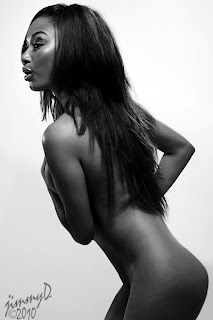
A friend sent me a link to a thread on
Model Mayhem which in turn led to an
interesting link that featured some photos with mark-ups for retouching. (For a few Playboy centerfold pics.)
In that thread, well-known glamour and fetish photographer,
Ken Marcus, commented about his days shooting for Playboy. In his comment, Ken said, "During the 11 years (1974 - 1985) that I shot centerfolds, calendars, pictorials and editorials for Playboy, there was a policy against retouching anything except the cover (to make sure text would contrast properly and be easily readable) Our policy during those days was: Pre-touch, rather than Re-touch."
Ken's words got me to thinking about the current state of glamour photography (in the digital age) and it's seeming dependence on post-production tools for making, leastwise hoping to make, impressive images. Often enough, heavily processed and re-touch-driven images either go beyond my ability to suspend disbelief or they simply suck as a result of the excessive and ridiculous amounts of processing and re-touching some photographers apply to their work.
I've probably beaten this subject to death in the past but nothing in the present has changed my opinion in terms of re-touching-- That is, that less is often more.
What I mean by "less is more" has less to do with the time and effort spent re-touching images and more to do with its obviousness.
When I was an editor (I'm talking video editor) one of the important things I learned about editing, be it film or video, was that the best editing is invisible. In other words, great editing doesn't call attention to itself: Cuts and dissolves and other edits all flow naturally, seamlessly, and invisibly. That's why motion picture editing is often referred to as "the soul" of a motion picture. It's there but viewer's aren't overly aware it's there.
In more than a few ways, I think re-touching photographic images is best accomplished when the re-touching is nearly invisible, calls little attention to itself, and seems natural. There are exceptions, of course. But those exceptions, in my opinion, generally refer to images that are as much digital art, perhaps more so, than they are photographs.
In order to produce photographs of high-caliber, the emphasis should be, as Ken Marcus mentioned, on pre-touch rather than re-touch. What that means is photographers should be learning all they can about the front-end of photography and doing everything they can, while in production, to reduce their reliance on re-touching to improve the quality of their photos.
In other words, pre-touch rather than re-touch.
Henri Carier-Bresson said, "The picture is good or not from the moment it was caught in the camera." That simple statement holds much truth!
Cartier-Bresson also said, "Your first 10,000 photographs are your worst." So, with that in mind, be patient. Keep working at improving you production skills. It doesn't happen overnight but, if you keep at it, it will happen. When it does, I think you'll find that pre-touch will trump re-touch in terms of producing good photos, glamour or otherwise.
The pretty girl at the top is Alexis from a shoot last night. I had about 15 minutes with Alexis and spent less than 5 minutes re-touching the above image. Could I have done more? Re-touching that is? Sure. Would the image be vastly improved? I'm not so sure. Improved, yes. Vastly improved? I don't know. Sometimes, things like re-touching (photographically) adheres to the law of diminishing returns.
 Well, another year comes to a close and, along with it, the first decade of the new millennium lies behind us as well. You'll have to wait a thousand years for another 1-1-11 to come along!
Well, another year comes to a close and, along with it, the first decade of the new millennium lies behind us as well. You'll have to wait a thousand years for another 1-1-11 to come along!









